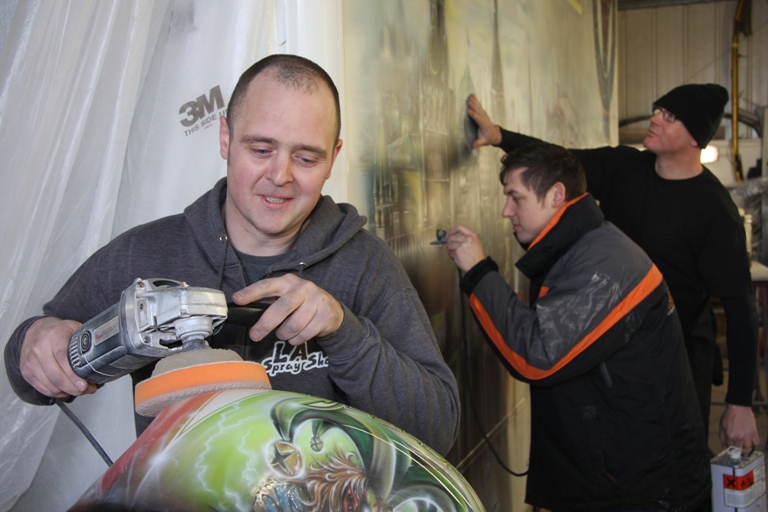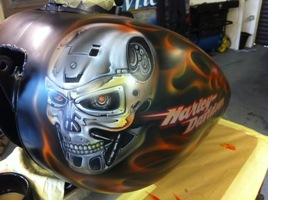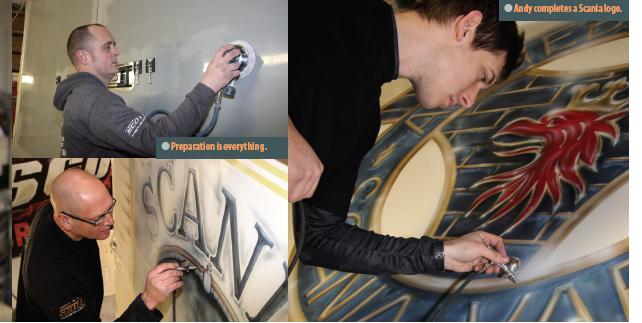Steve Jordan went back to his Yorkshire roots to visit custom artist Andy Scott in Barnsley, the company responsible for much of the exotic artwork seen on vehicles brightening up the roads of Britain.

So, you think you’ve seen a paint shop! Well, so did I, until I turned up at Barnsley to visit Andy Scott, his son Tom and their business partner Lee Atchison. Then my eyes were opened. Of course, I have seen custom paint jobs before, even if just in magazines, but I’d never seen them being done. I’m not sure what I expected, but it wasn’t this.
Living in a computerised world makes us all a little blasé about talent. Not that computers don’t release talented people to be able to re-create what’s in their heads, and that’s impressive enough, but when you see people creating art without technology, just using their own skill, it’s breath taking. In fact, after I left, as I drove out of the Barnsley trading estate from which the lads work, I was already beginning to doubt what I had seen with my own eyes.
 I was, at first, a little nervous about asking how they did it. I wanted to get a good story but I didn’t want to break the mystery, to give away trade secrets that might in any way devalue what they did. I needn’t have worried. There is no mystery. There are no tricks. Microsoft hasn’t yet produced a plug and play program that will let us all master the techniques in an afternoon. No, this is just unaided genius; if you don’t have the gift, you won’t learn it – no matter how you try.
I was, at first, a little nervous about asking how they did it. I wanted to get a good story but I didn’t want to break the mystery, to give away trade secrets that might in any way devalue what they did. I needn’t have worried. There is no mystery. There are no tricks. Microsoft hasn’t yet produced a plug and play program that will let us all master the techniques in an afternoon. No, this is just unaided genius; if you don’t have the gift, you won’t learn it – no matter how you try.
But there is a process, and this surprised me too. It requires the customer to give Andy or Tom a theme as detailed or as broad as they like. That’s when computers do make a brief appearance. Tom creates a draft design for the customer to approve. After that, it’s just manual labour.
First step is to prepare the vehicle. I’d imagined a good scrub with a bucket of Flash and you are away. No, that’s not how it works. Preparation is Lee’s job. It’s a vitally important part of the process that brings the vehicle up to ‘better than new’ condition and presents Andy and Tom with the best possible painting surface. Lee checks the vehicle for damage, replaced any imperfect parts, and modifies the vehicle if necessary. He then smooths out any scratches, dents, ripples and creases. He even rehangs the doors if they are not perfectly flush. “Any imperfections will really stand out when we put the high-gloss finish on,” he explains. “It’s either right, or it’s no good at all.” That’s where the attention to detail starts and continues throughout. Next comes the base painting that provides the perfect surface for, as Lee puts it, “The guys to do their magic.”
And magic it truly is. I had imagined some kind of sign writers’ Jacquard equivalent that would transfer the basic image onto the vehicle for the painters to follow: a kind of painting my numbers. No way! With customer-approved design in one hand and a pencil, brush or air brush in the other, Andy and Tom just start work. “But how can this be,” I asked? It just defies logic. With a whole expanse of a lorry side as a canvass how can it be possible to ‘just start’ without anything, apparently, as a guide? The answer is simple.
 Andy was drawing and painting before he went to school. When he got his first push bike, he painted it. When he got his first motorbike he did the same thing. “All my mates wanted theirs doing too so we were all going about on custom-painted mopeds,” he said. Then he got a car, a mini, and painted that, and people asked him to do theirs. “It’s all I have ever wanted to do.” He’s been doing it now for 32 years.
Andy was drawing and painting before he went to school. When he got his first push bike, he painted it. When he got his first motorbike he did the same thing. “All my mates wanted theirs doing too so we were all going about on custom-painted mopeds,” he said. Then he got a car, a mini, and painted that, and people asked him to do theirs. “It’s all I have ever wanted to do.” He’s been doing it now for 32 years.
Tom too has inherited his father’s gift. He attended the same college in Rotherham and now has this quite unbelievable ability to transfer designs from paper to vehicle with a precision and flair that I have never witnessed before. “Some people say we are like artists,” he said. There’s no doubt about it Tom, you are artists all right.
Still sceptical, I probed more. I have been around testosterone-driven workshops often enough to recognise a wind-up opportunity when I see one. There just had to be a trick. Andy was working on the back door of his latest project, a Scania road train for Matthew James Removals. The design included a full width Scania logo. I asked how he could get the lettering spot on just by eye. Andy sighed a tolerant sign, stepped off the platform and, with the aid of nothing more than a pencil and a piece of string wrote my name on the white workshop wall, in exactly the same font and style, in two minutes flat. He then returned to his work. I was speechless.
 When the artwork is complete and approved, Lee returns. His task now is to provide the finishing touches; to convert the delicate painted surface into a colour-fast, scratch-resistant, glass-like surface that will provide years of service, accentuate the colours, and make sure the paint looks great now and for decades to come if necessary. I watched him do it. Each coat carefully applied, rubbed down and applied again, maybe up to ten times, to create the depth of shine and to make sure that any relief in the paint is covered and protected. “Look, you can see where this is rippled,” he said, pointing out an area of a motor bike petrol tank. I nodded, unable to see a single blemish. “I use 2000-grit paper until I get it perfect.” It’s then fully waxed and every piece individually valeted to it’s immaculate inside and out. See what I mean about detail!
When the artwork is complete and approved, Lee returns. His task now is to provide the finishing touches; to convert the delicate painted surface into a colour-fast, scratch-resistant, glass-like surface that will provide years of service, accentuate the colours, and make sure the paint looks great now and for decades to come if necessary. I watched him do it. Each coat carefully applied, rubbed down and applied again, maybe up to ten times, to create the depth of shine and to make sure that any relief in the paint is covered and protected. “Look, you can see where this is rippled,” he said, pointing out an area of a motor bike petrol tank. I nodded, unable to see a single blemish. “I use 2000-grit paper until I get it perfect.” It’s then fully waxed and every piece individually valeted to it’s immaculate inside and out. See what I mean about detail!
In his career Andy’s work has graced the front cover of glossy magazines many times. He says his first cover of Custom Car was the pinnacle. Today the lads paint bikes, cars, vans and trucks for companies who really want to make a statement. Their work maintains and often creates a company’s image making vehicles stand out in the crowd in a way that cannot help but impress.
“But why bother painting rather than using vinyl wrapping,” I asked what I thought might be a reasonable question. Andy stopped short of escorting me from the building to explain that vinyl shrinks after a few months and discolours and if it gets damaged it’s wrecked … and …and …. I got the idea pretty quickly.
 How much does it cost? Well that could be just about anything depending on what’s involved. A small airbrushed image on a car or van might be a few hundred, a whole van maybe a few thousand and a road train – well, probably better not ask. But it does say something about the owner that is hard to put into words: quality, attention to detail, pride in a job well done and, a sense of humour, essential for successful business.
How much does it cost? Well that could be just about anything depending on what’s involved. A small airbrushed image on a car or van might be a few hundred, a whole van maybe a few thousand and a road train – well, probably better not ask. But it does say something about the owner that is hard to put into words: quality, attention to detail, pride in a job well done and, a sense of humour, essential for successful business.
Do you fancy having one of your vans converted into a travelling piece of art to show off your business and create the wow factor? If you do you’d better get booked in early. It’s not a job to be rushed. It’s got to be right. Oh, and there’s one other thing. Andy is a bit OCD on time. If he says it will be ready for Truckfest, next Wednesday, your grandma's birthday or the BAR conference, it will be. No mistake.
To get in touch contact Andy at: custom_painthouse@yahoo.com
Photos top to bottom: Genius at work; An example of the Scotts' motorcycle tank art; Lee Atchison, Andy Scott and Tom Scott; Another example of the Scotts' airbrushing skills. Click here to see the next Editor's pick.